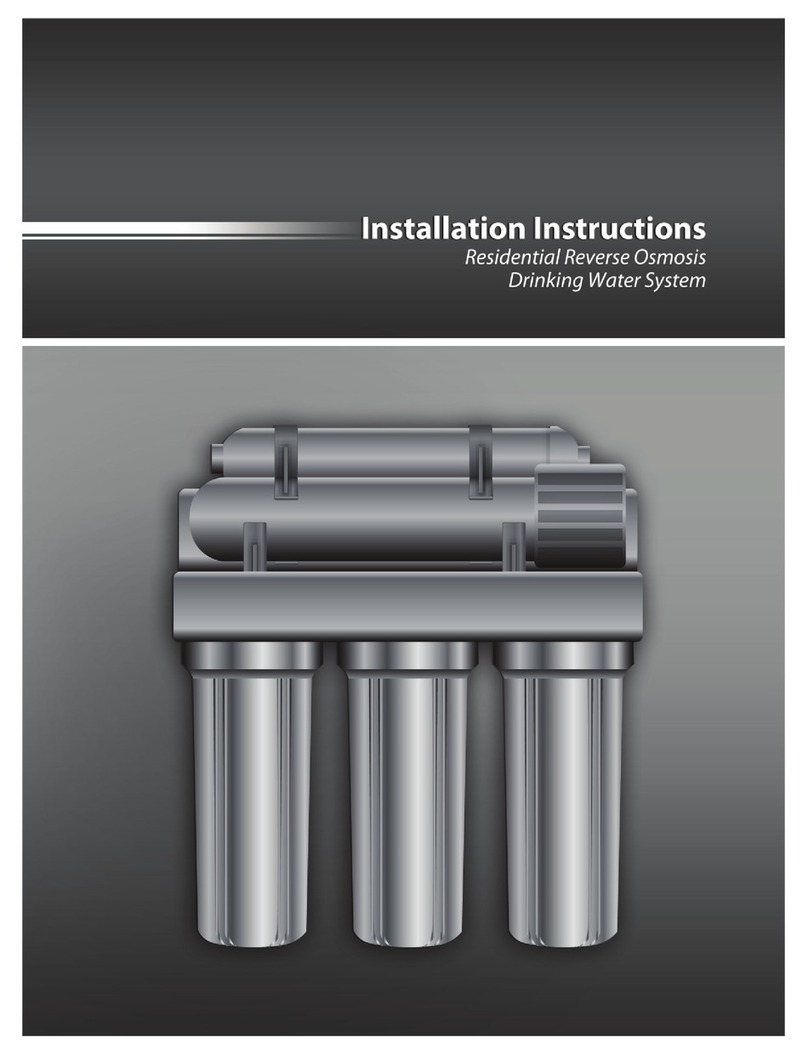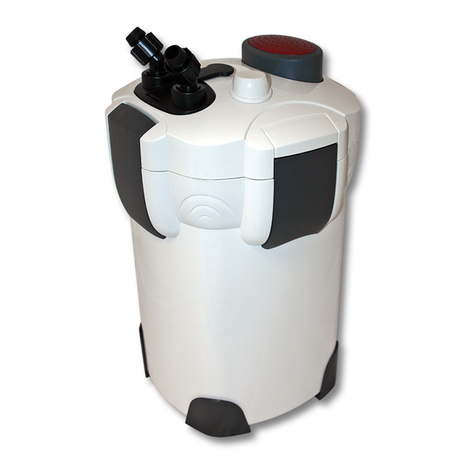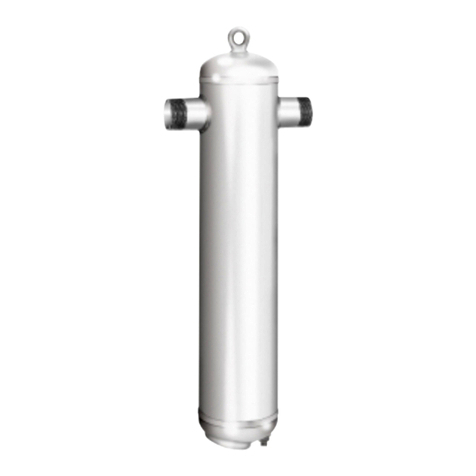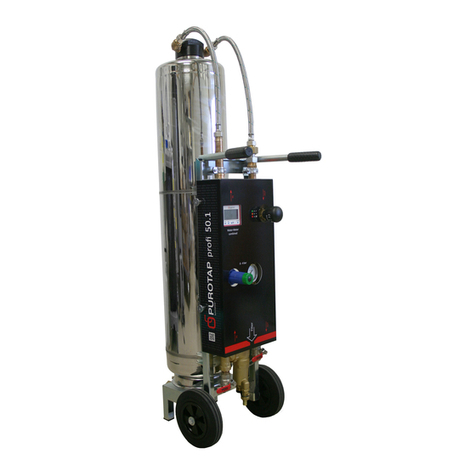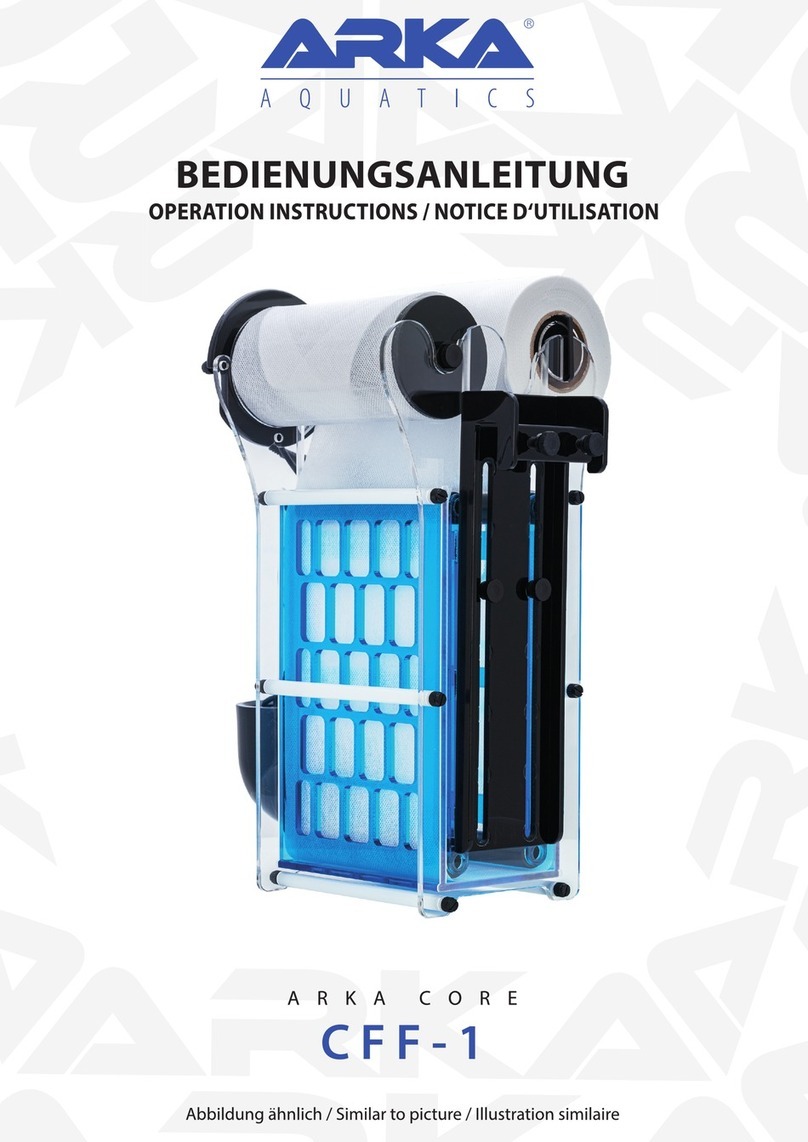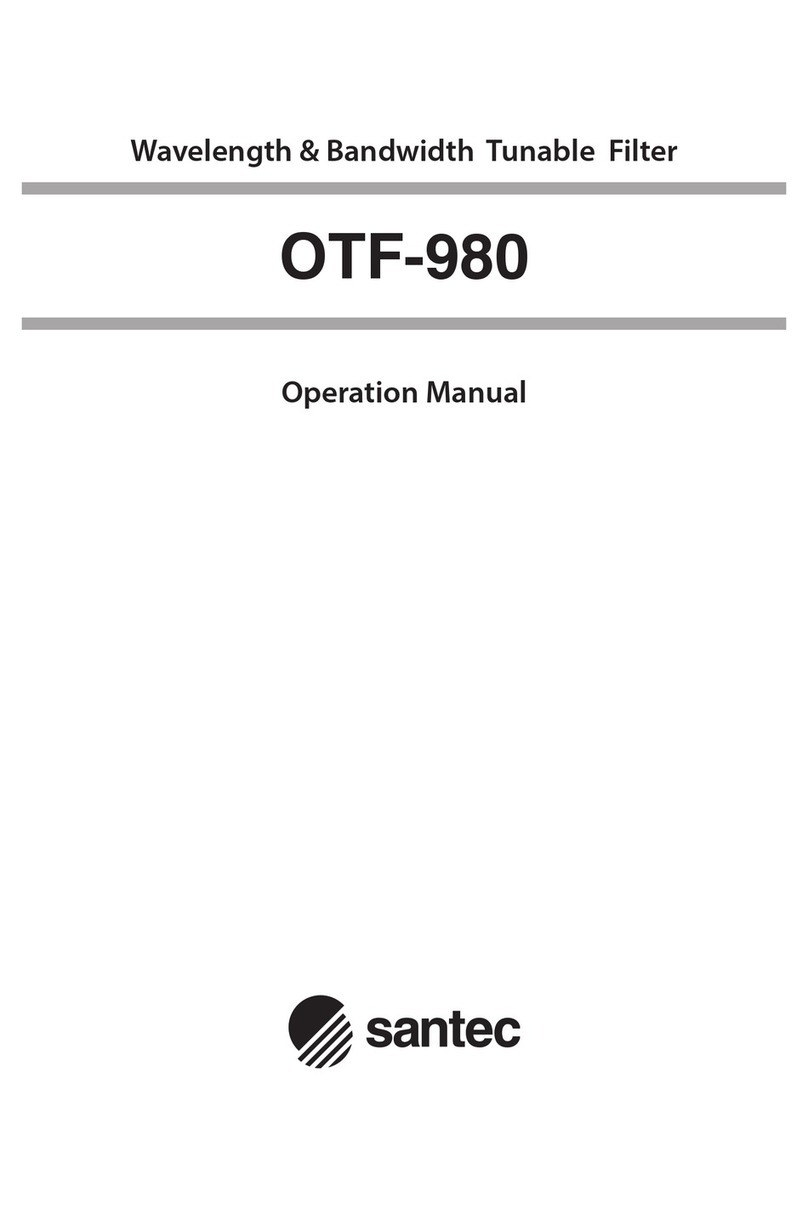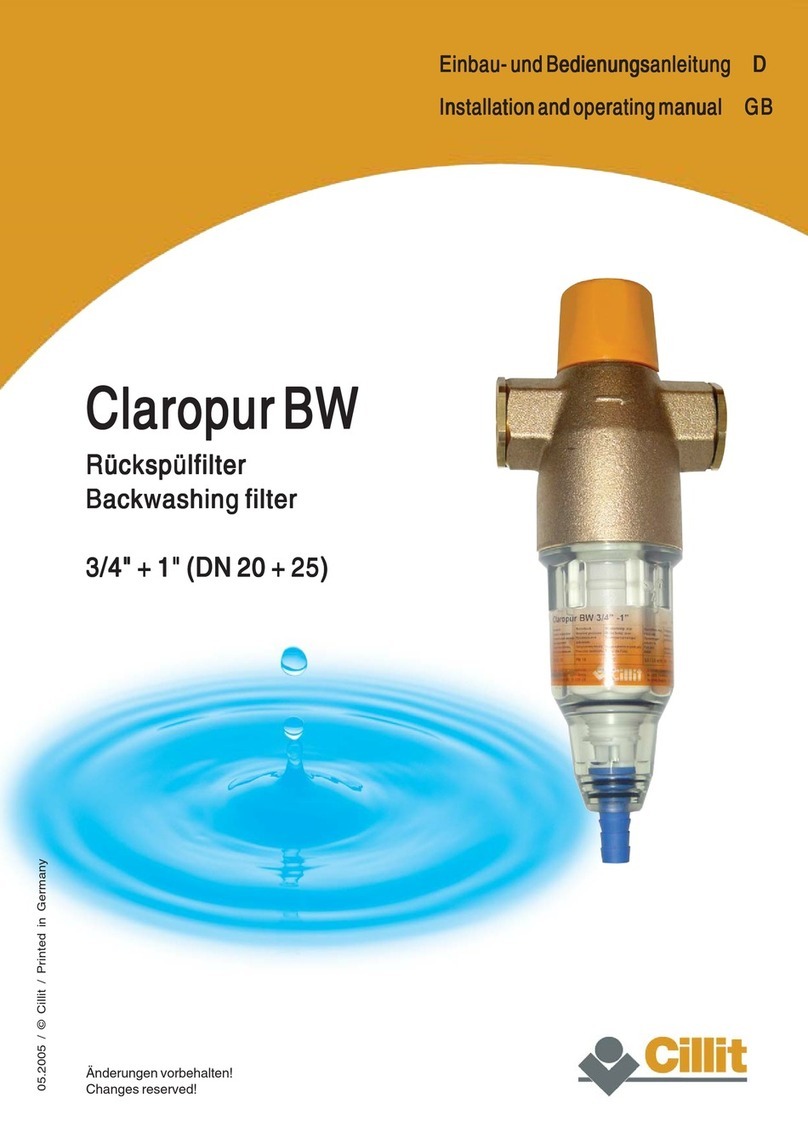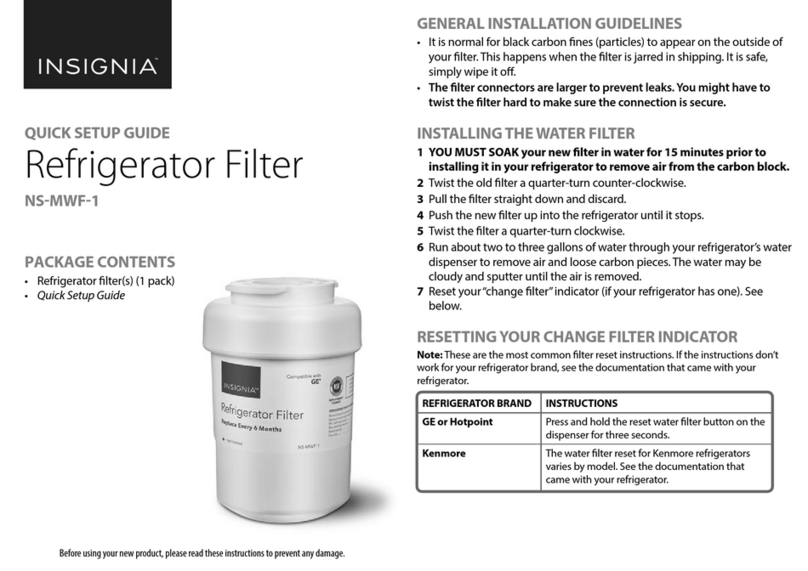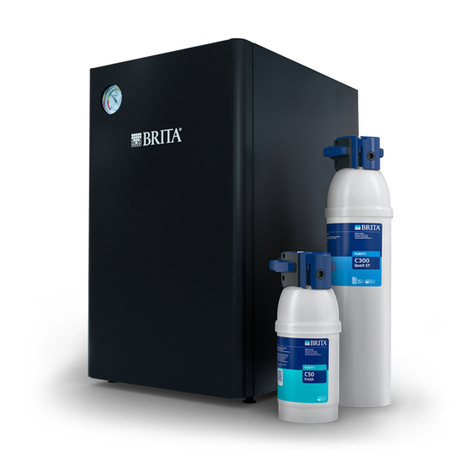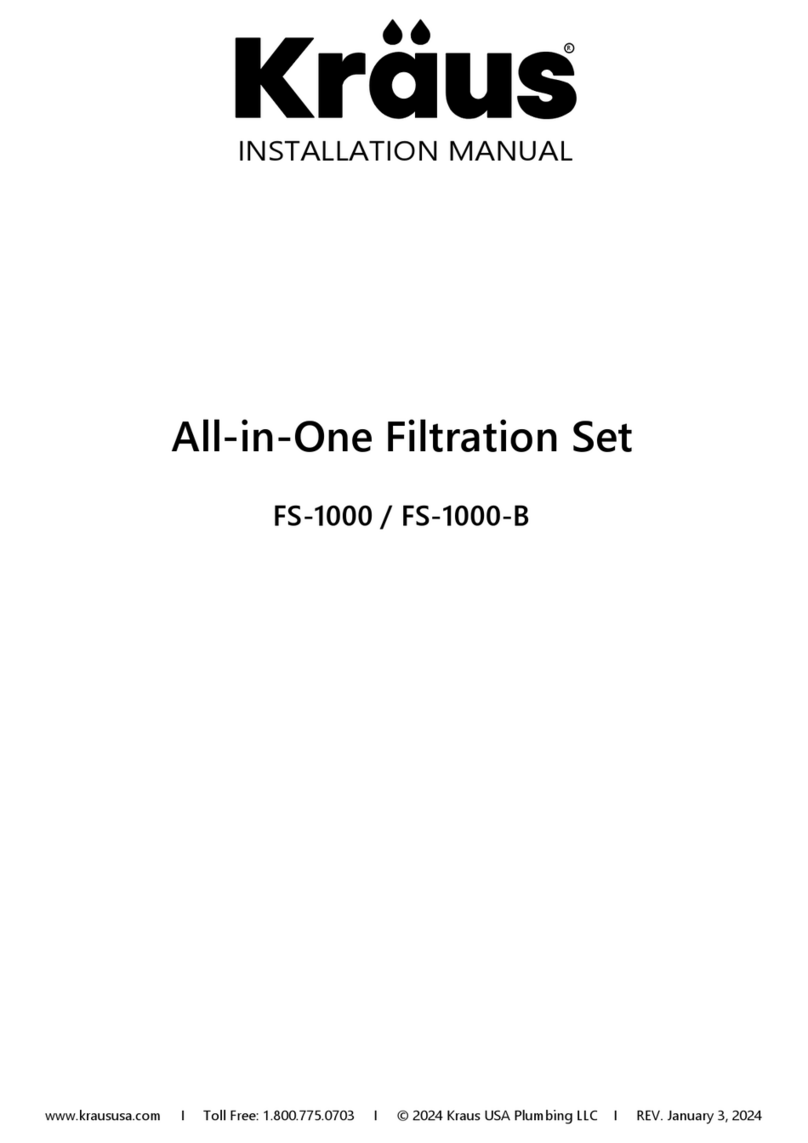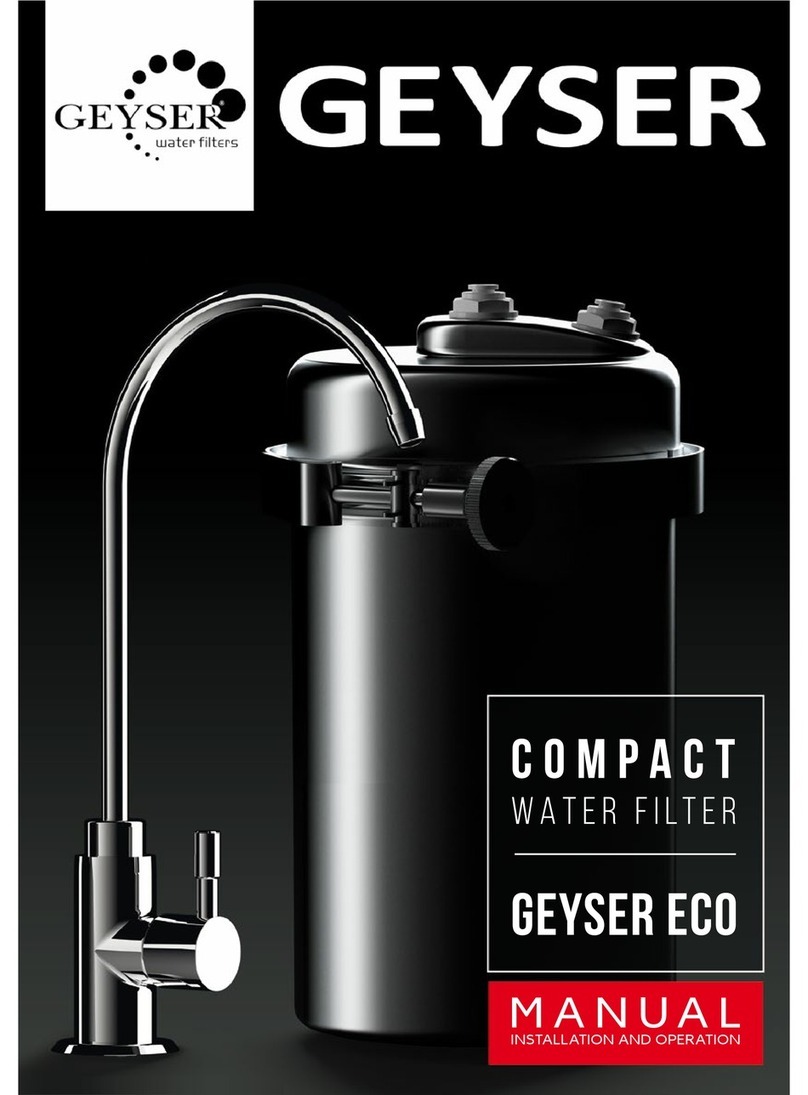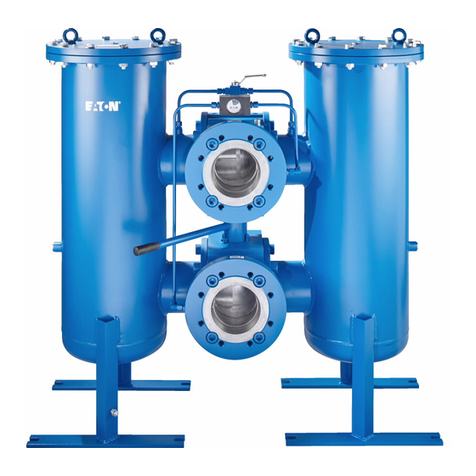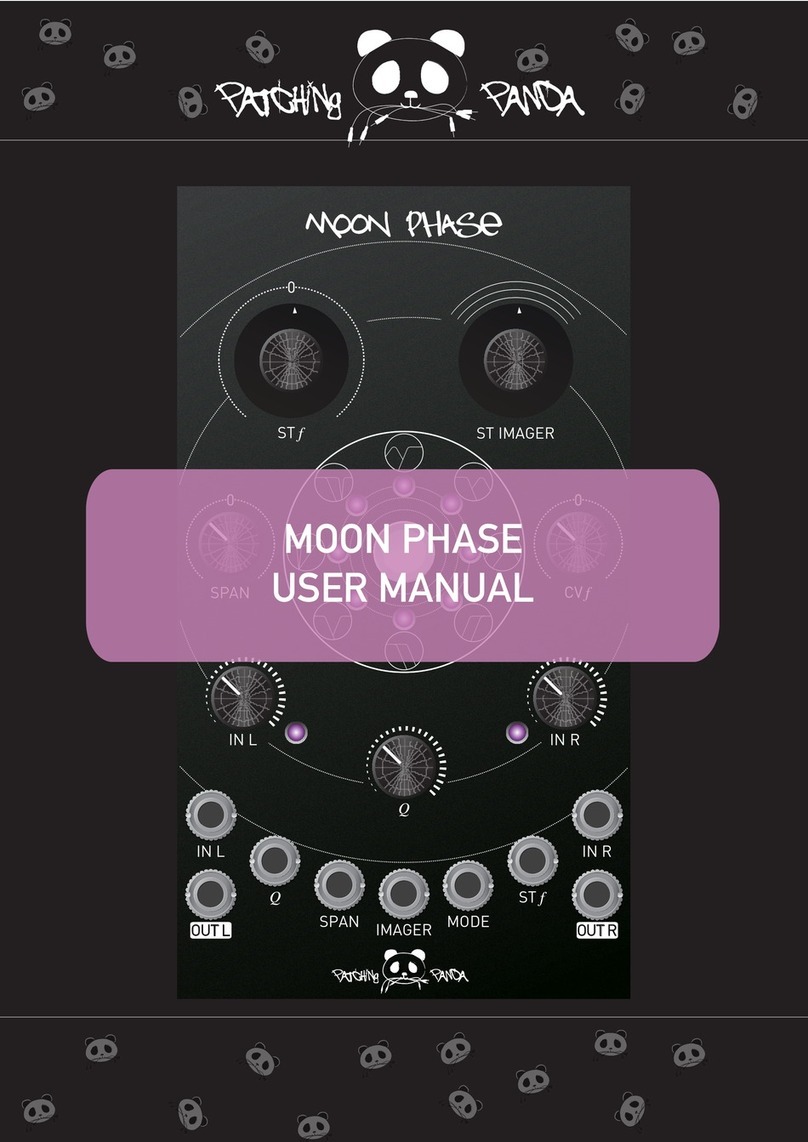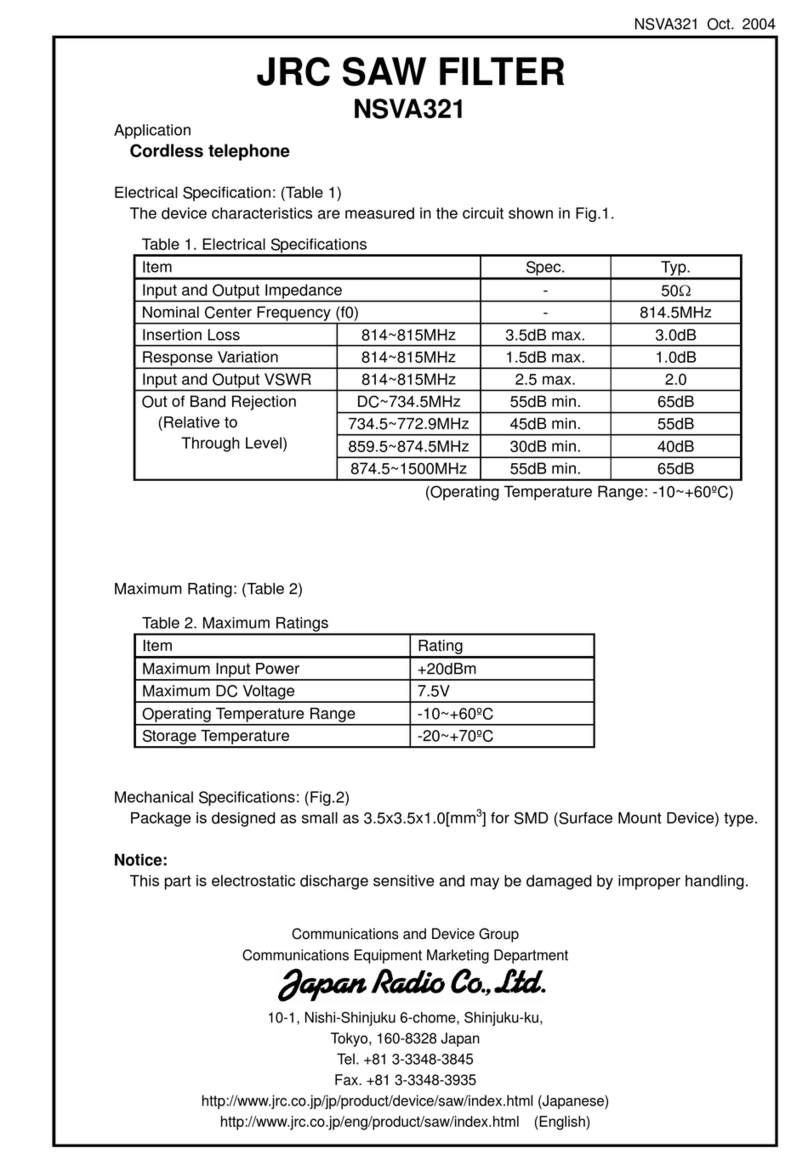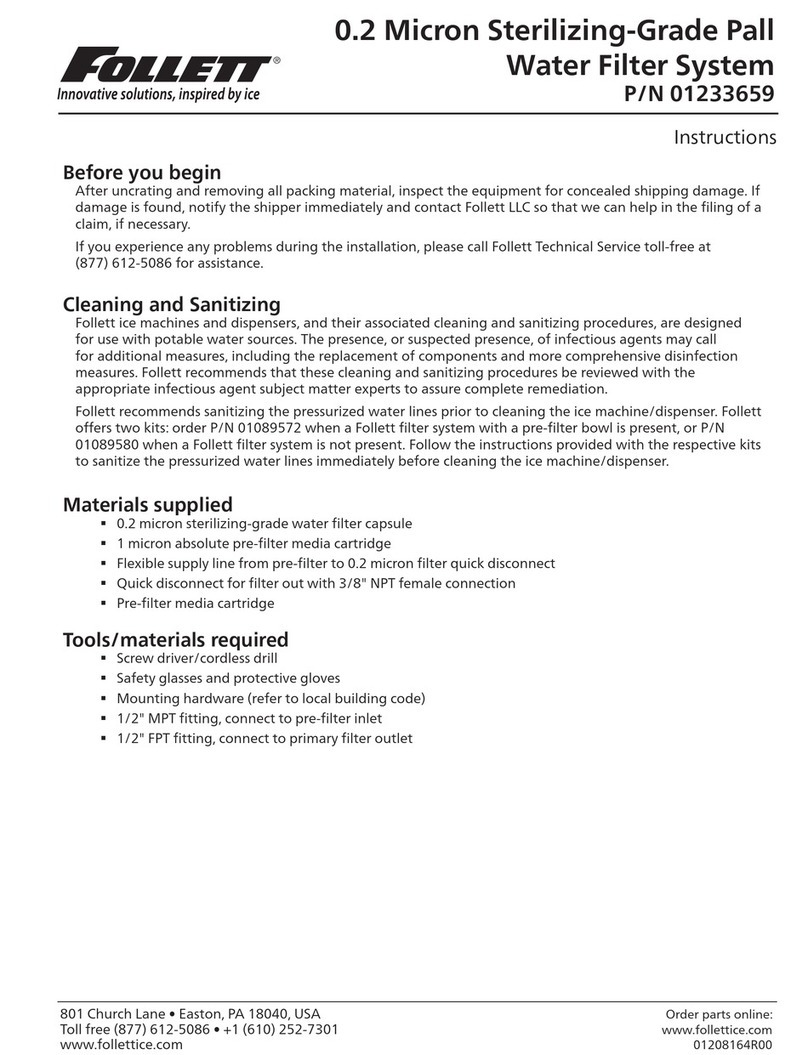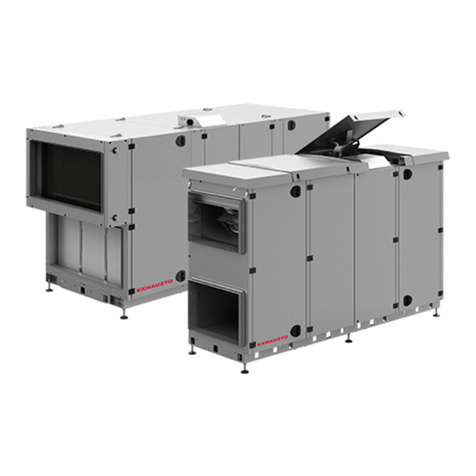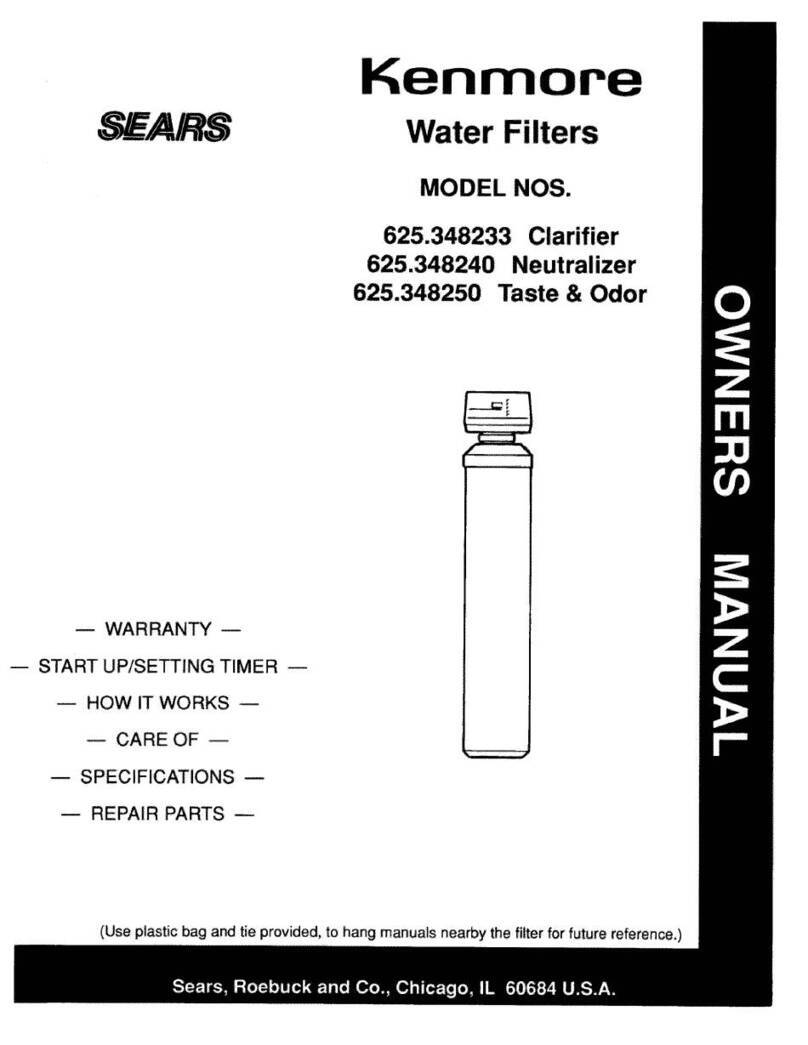Tier1 WH-RO-700 User manual

Membrane System
User Manual
TIER1-WH-RO-350 and TIER1-WH-RO-700

2
This page intentionally
left blank
w

3
TABLE OF CONTENTS
INTRODUCTION ............................................................................................................4
SAFETY..........................................................................................................................5
FEEDWATER AND OPERATION SPECIFICATIONS.....................................................6
REJECTION, RECOVERY AND FLOW RATES .............................................................7
INSTALLATION GUIDELINES TIER1-WH-RO-350 AND 700 ... .....................................8
ELECTRICAL................................................................................................................10
MEMBRANE ELEMENTS.............................................................................................11
SYSTEM IDENTIFICATIONS........................................................................................12
MEMBRANE INSTALLATION, REMOVAL AND REPLACEMENT................................15
SYSTEM PURGING AND INITIAL START–UP............................................................. 17
OPERATING DO’S AND DON’TS.................................................................................18
RO SHUT–DOWN PROCEDURE.................................................................................18
PRODUCT SPECIFICATIONS...................................................................................... 19
OPERATING LIMITS .................................................................................................... 20
PREPARING UNIT FOR STORAGE AND SHIPMENT................................................. 21
TROUBLESHOOTING.................................................................................................. 22
OPERATING LOG........................................................................................................24
TEMPERATURE CORRECTION FACTORS FOR MEMBRANE ..................................25
SERVICE ASSISTANCE............................................................................................... 26
SYSTEM DIAGRAMS...................................................................................................27
SYSTEM WARRANTY..................................................................................................29

4
INTRODUCTION
Your Tier1- Series Reverse Osmosis System is a durable piece of equipment which, with
proper care, will last for many years. This User Manual outlines installation, operation,
maintenance and troubleshooting details vital to the sustained performance of your
system.
If your system is altered at the site of operation, or if the feedwater conditions change,
please contact your local dealer or distributor to determine the proper recovery for your
application.
IN ORDER TO MAINTAIN THE MANUFACTURER’S WARRANTY, AN
OPERATING LOG MUST BE MAINTAINED AND COPIES WILL NEED TO BE
SENT TO YOUR LOCAL DEALER OR DISTRIBUTOR FOR REVIEW.
PRIOR TO OPERATING OR SERVICING THE REVERSE OSMOSIS SYSTEM,
THIS USER MANUAL MUST BE READ AND FULLY UNDERSTOOD. KEEP THIS
AND OTHER ASSOCIATED INFORMATION FOR FUTURE REFERENCE AND
FOR NEW OPERATORS OR QUALIFIED PERSONNEL NEAR THE SYSTEM.

5
SAFETY
The Safety section of this User Manual outlines the various safety headings used throughout
this manual’s text and are enhanced and defined below:
CAUTION: INDICATES STATEMENTS THAT ARE USED TO IDENTIFY
CONDITIONS OR PRACTICES THAT COULD RESULT IN EQUIPMENT OR
OTHER PROPERTY DAMAGE.
WARNING: INDICATES STATEMENTS THAT ARE USED TO IDENTIFY
CONDITIONS OR PRACTICES THAT COULD RESULT IN INJURY OR LOSS
OF LIFE. FAILURE TO FOLLOW WARNINGS COULD RESULT IN SERIOUS
INJURY OR EVEN DEATH.
DO NOT, UNDER ANY CIRCUMSTANCES, REMOVE ANY CAUTION,
WARNING OR OTHER DESCRIPTIVE LABELS FROM THE SYSTEM.
PLEASE READ THE ENTIRE MANUAL BEFORE PROCEEDING WITH
THE INSTALLATION AND START–UP. FAILURE TO FOLLOW
INSTRUCTIONS OR OPERATING PARAMETERS MAY LEAD TO THE
PRODUCT’S FAILURE, WHICH CAN CAUSE PROPERTY DAMAGE
AND/OR PERSONAL INJURY.
•
DO NOT USE WHERE THE WATER IS MICROBIOLOGICALLY UNSAFE OR OF
UNKNOWN QUALITY WITHOUT ADEQUATE DISINFECTION BEFORE OR AFTER
THE SYSTEM.
•
PRE–TREATMENT MUST BE SUFFICIENT TO ELIMINATE CHEMICALS,
ORGANICS OR INORGANICS THAT COULD ATTACK THE MEMBRANE MATERIAL.
•
ALWAYS TURN OFF THE UNIT, SHUT OFF THE FEEDWATER AND DISCONNECT
THE ELECTRICAL POWER BEFORE WORKING ON THE UNIT.
•
NEVER ALLOW THE PUMP TO RUN DRY.
•
NEVER ALLOW THE UNIT TO FREEZE OR OPERATE WITH A FEEDWATER
TEMPERATURE ABOVE 85°F.

6
FEEDWATER AND OPERATION SPECIFICATIONS
Nothing has a greater effect on a reverse osmosis system than the feedwater quality.
IT IS VERY IMPORTANT TO MEET THE MINIMUM FEEDWATER
REQUIREMENTS. FAILURE TO DO SO WILL CAUSE THE MEMBRANES
TO FOUL AND VOID THE MANUFACTURER’S WARRANTY.
OPERATING LIMITS*
Operating Parameters:
Feed Temperature
40 –85°F
System Inlet Pressure
70 –90 PSI
Maximum Operating Pressure (at 77°F)
90 PSI
Feedwater Requirements:
Maximum SDI Rating
< 3
Maximum Turbidity
1 NTU
Maximum Free Chlorine and/or Chloramines
0 PPM
PH (Continuous)
2 –11
PH (Cleaning for 30 minutes)
1 –13
*If any of the feedwater parameters are not within the limits given, consult your local dealer or distributor for
assistance.
HIGHER TDS AND/OR LOWER TEMPERATURES WILL REDUCE THE SYSTEM’S
PRODUCTION.

7
REJECTION, RECOVERY AND FLOW RATES
The amount of total dissolved solids (TDS) rejected by the membrane is expressed
as a percentage. For example, a 98% rejection rate means that 98% of total
dissolved solids do not pass through the membrane. To calculate the percentage of
rejection, use the following formula:
% Rejection = [(Feed TDS –Product TDS) / Feed TDS] x 100
Example:
98% = [(550 –11) / 550] x 100
ALL TDS FIGURES MUST BE EXPRESSED IN THE SAME UNITS, TYPICALLY
PARTS PER MILLION (PPM) OR MILLIGRAMS PER LITER (MG/L).
Tier1 –Series Reverse Osmosis Systems are designed to reject up to 98% NaCl,
unless computer projections have been provided or stated otherwise.
The amount of permeate water recovered for use is expressed as a percentage. To
calculate the percentage of recovery, use the following formula:
% Recovery = (Product Water Flow Rate / Feed Water Flow Rate) x 100
Example:
50% = (1.02 / 2.04) x 100
ALL FLOW RATES MUST BE EXPRESSED IN THE SAME UNITS, TYPICALLY
GALLONS PER MINUTE (GPM).

8
INSTALLATION GUIDELINES Tier1–350AND Tier1–700
PLUMBING
The membranes used on RO-350 and RO-700 systems require a continuous flow of
water with a minimum feed pressure of 70 psi, not to exceed 90 psi.
Be certain that all of the components of the feedwater are soluble at the concentrations
attained in the system.
1. Inspect the system for any damage that could have occurred during shipment.
Although the system has been individually inspected, complete a quick inspection
of the fittings, tubing and other components.
2. Please provide a reasonable amount of space for installation and leave six inches
of space below the filter housings for ease of maintenance.
THE REVERSE OSMOSIS SYSTEM SHOULD BE INSTALLED IN AN
AREA THAT IS NOT IN DIRECT SUNLIGHT OR EXTREME COLD.
3. Connect a 3/8” tube from an incoming water source to the 3/8” QC fitting labeled
FEED.
DO NOT OPERATE AT A PRESSURE EXCEEDING 90 PSI.
4. Connect 3/8” tubing from the 3/8” QC fitting labeled CONCENTRATE to drain
(waste). Run the concentrate line to an open drain in a free and unrestricted
manner (no backpressure).
5. This system has been designed to operate together with an external bladder or
atmospheric tank. Connect 3/8” tubing from the 3/8” QC fitting labeled HOLDING
TANK to a permeate storage tank.
THE AUTO SHUTOFF VALVE WILL SHUT THE SYSTEM OFF AUTOMATICALLY
WHEN THE BLADDER TANK IS FULL.

9
6. The sediment and carbon filters must be changed regularly for optimal
performance. The filters and water quality should be checked every two weeks
minimum.
Note: The permeate water must be directed to drain for the first 30 minutes of
use. Do not fill storage tank until the system has been flushed for 30 minutes.
7. Connect 3/8” tubing from the 3/8” QC bulkhead labeled PERMEATE to the final
point–of–use (i.e. faucet). Ensure that the permeate water can flow freely with no
backpressure. Backpressure can cause irreversible damage to the membrane
elements.
8. Use any TDS or conductivity meter to monitor the product water quality.
ANY CHLORINE EXPOSURE WILL DAMAGE THE MEMBRANE
PERMANENTLY.
Note: This system is equipped with an auto shut off valve (ASOV). The ASOV
will turn the system on when the permeate pressure is below 18 +/–5 psi and will
shut the system off when the permeate pressure is 48 +/–5 psi. If using an
atmospheric storage tank, a float switch will be required to turn the system on
and off.
THE PH OF THE REVERSE OSMOSIS PERMEATE WATER WILL TYPICALLY BE
1 OR 2 PH UNITS LOWER THAN THE FEEDWATER PH. A LOW PH CAN BE
VERY AGGRESSIVE TO SOME PLUMBING MATERIALS SUCH AS COPPER
PIPING.
ANY RESTRICTIONS OR BLOCKAGE IN THE DRAIN LINE CAN CAUSE
BACKPRESSURE, WHICH WILL INCREASE THE SYSTEM’S
OPERATING PRESSURE. THIS CAN RESULT IN DAMAGE TO THE
SYSTEM’S MEMBRANES AND COMPONENTS.

10
ELECTRICAL
Ensure that the electrical circuit supplying the system is compatible with the requirements
of the specific Tier1 –Series model you are installing.
TO REDUCE THE RISK OF ELECTRICAL SHOCK, THE INCOMING
POWER SUPPLY MUST INCLUDE A PROTECTIVE EARTH GROUND.
PRE–FILTRATION
Tier1 –Series systems are supplied with a 5–micron sediment filter and 10–micron
carbon block filter. Change the cartridge once a month or when a 10 –15 psi differential
exists between the feed supply water pressure and filter out pressure.
THE SYSTEM MUST BE OPERATED ON FILTERED WATER ONLY.
MOUNTING
The free standing system should be bolted down or securely fastened in compliance with
local regulation standards. The system comes standard with a rubber bumper kit.
Casters and levelers are available but optional.

11
MEMBRANE ELEMENTS
The Tier1 –Series Reverse Osmosis Systems are equipped with AXEON TF –Series Membrane
Elements. General membrane element performance characteristics are listed below.
TF–3012–500 Membranes
Membrane Type: Polyamide Thin –Film Composite
pH Range, Short Term Cleaning (30 Min.): 1 –13
Maximum Operating Temperature: 113°F (45°C)
Maximum Feed Silt Density Index (SDI): 5
Maximum Operating Pressure: 150 psi (10 bar)
Chlorine Tolerance: 0 ppm
pH Range, Continuous Operation*:2 –11
Maximum Feed Flow Rate (gpm): 2
*Maximum temperature for continuous operations above pH10 is 95°F (35°C).
Product Specifications
Part
Number
Description
Applied
Pressure
psi / bar
Permeate
Flow Rate
gpd / m3/d
Nominal
Salt
Rejection
(%)
200357
TF–1812–25
50 / 3.40
25 / 3.94
98
200358
TF–1812–35
50 / 3.40
35 / 5.52
98
200359
TF–1812–50
50 / 3.40
50 / 7.88
98
200360
TF–1812–75
50 / 3.40
75 / 11.83
98
200361
TF–1812–100
60 / 4.13
100 / 15.77
98
200362
TF–1812–150
65 / 4.48
150 / 23.66
98
208795
TF–1812–200
65 / 4.48
200 / 31.50
98
208802
TF–3012–500
70 / 4.80
500 / 78.86
98
Warranty Evaluation Test Conditions: Permeate flow and salt rejection based on the following test conditions –550 ppm, filtered and dechlorinated municipal tap water, 77°F / 25°C, 15% recovery
and the specified operating pressure. Minimum salt rejection is 96%. Permeate flows for warranty evaluation may vary +/–20%. Maximum pressure drops at 13 psi / 0.9 bar.
Proper start–up of reverse osmosis water treatment systems is essential to prepare the membranes for operating service and to prevent membrane damage due to
overfeeding or hydraulic shock. Before initiating system start–up procedures, membrane pretreatment, loading of the membrane elements, instrument calibration and
other system checks should be completed.
Avoid any abrupt pressure or cross–flow variations on the spiral elements during start–up, shutdown, cleaning or other sequences to prevent possible membrane
damage. During start–up, a gradual change from a standstill to operating state is recommended as follows:
Feed pressure should be increased gradually over a 30 –60 second time frame.
Cross–flow velocity at set operating point should be achieved gradually over 15 –20 seconds.
Permeate obtained from first hour of operation should be discarded.
Maximum pressure drops across an entire pressure vessel (housing) is 30 psi / 2.1 bar.
Avoid static permeate–side backpressure at all times.
Under certain conditions, the presence of free chlorine, chloramines and other oxidizing agents will cause premature membrane failure. Since oxidation damage is not
covered under warranty, the manufacturer recommends removing all oxidizing agents by pretreatment prior to membrane exposure. Please contact the manufacturer
or your supplier for more information.
Do not use this initial permeate for drinking water or food preparation. Keep elements moist at all times after initial wetting. To prevent biological growth during
prolonged system shutdowns, it is recommended that membrane elements be immersed in a preservative solution. Rinse out the preservative before use. For
membrane warranty details, please contact the manufacturer or your supplier for more information.
If operating limits and guidelines given in this product specification sheet are not strictly followed, the warranty will be null and void. The customer is fully responsible
for the effects of incompatible chemicals and lubricants on elements. Use of any such chemicals or lubricants will void the warranty. These membranes may be
subject to drinking water application restrictions in some countries: please check the application status before use and sale. The use of this product in and of itself
does not necessarily guarantee the removal of cysts and pathogens from water. Effective cyst and pathogen reduction is dependent on the complete system design
and on the operation and maintenance of the system.
No freedom from infringement of any patent owned by the manufacturer or others is to be inferred. Because use conditions and applicable laws may differ from one
location to another and may change with time, customer is responsible for determining whether products and the information in this document are appropriate for
customer’s use and for ensuring that customer’s workplace and disposal practices are in compliance with applicable laws and other governmental enactments. The
claims made may not have been approved for use in all countries. The manufacturer assumes no obligation or liability for the information in this document. NO
WARRANTIES ARE GIVEN; ALL IMPLIED WARRANTIES OF MERCHANTABILITY OR FITNESS FOR A PARTICULAR PURPOSE ARE EXPRESSLY EXCLUDED.
Dimensions (in / mm)
Description
A
B
C
D
E
TF–1812–25
11.75 /
298.45
10.00 /
254.00
0.86 /
21.84
0.88 /
22.35
1.77 /
45.08
TF–1812–35
11.75 /
298.45
10.00 /
254.00
0.86 /
21.84
0.88 /
22.35
1.77 /
45.08
TF–1812–50
11.75 /
298.45
10.00 /
254.00
0.86 /
21.84
0.88 /
22.35
1.77 /
45.08
TF–1812–75
11.75 /
298.45
10.00 /
254.00
0.86 /
21.84
0.88 /
22.35
1.77 /
45.08
TF–1812–100
11.75 /
298.45
10.00 /
254.00
0.86 /
21.84
0.88 /
22.35
1.77 /
45.08
TF–1812–150
11.75 /
298.45
10.00 /
254.00
0.86 /
21.84
0.88 /
22.35
1.77 /
45.08
TF–1812–200
11.75 /
298.45
10.00 /
254.00
0.86 /
21.84
0.88 /
22.35
1.77 /
45.08
TF–3012–500
11.75 /
298.45
10.00 /
254.00
0.79 /
20.00
0.75 /
19.05
2.95 /
74.93

12
SYSTEM IDENTIFICATION TIER1-WH-RO-350
Figure 1

13
SYSTEM IDENTIFICATION TIER1-WH-RO-700
Figure 2

14
SYSTEM IDENTIFICATION
ITEM
NO.
DESCRIPTION
PART
NUMBER
MODEL(S)
1
HOUSING, FILTER, WHT/WHT, 2.5” X 20”, SGL O–RING, NPR, 3/8”
FNPT
207295
350–700
2
CARTRIDGE, SEDIMENT, POLYPRO, 2.5” X 20”, 5 MIC
200626
350–700
3
CARTRIDGE, CARBON, BLOCK, 2.5” X 20”, 10 MIC
200659
350–700
4
BRACKET, LC/LP–SERIES, STEEL, WHITE, 12GA
209408
350–700
5
HOUSING, MEMBRANE, 3012, WHT, ANGLE 3/8” FNPT
208438
350–700
6
MEMBRANE, ELEMENT, TF–3012–500, AXEON
208802
350–700
7
VALVE, AUTO SHUTOFF, 3/8” QC, ASOV
208079
350/ 700

15
MEMBRANE INSTALLATION, REMOVAL AND REPLACEMENT
Installation and replacing membranes in the pressure vessels is an easy process if you
have the proper information and tools at hand. Please refer to the following instructions
when removing and replacing membrane elements:
ALL PRESSURE GAUGES MUST READ ZERO BEFORE PROCEEDING.
BEFORE ATTEMPTING, DISCONNECT THE POWER FROM THE
SYSTEM AND BLEED ALL WATER PRESSURE FROM THE SYSTEM.
1. Disconnect the tubing from the pressure vessel end cap. Unthread the end
cap by turning it counter–clockwise.
2. Remove the replacement membrane element(s) from the shipping box; the
membrane(s) should be contained within a plastic bag.
WEAR GLOVES FOR THE FOLLOWING STEPS IN ORDER NOT TO
CONTAMINATE THE MEMBRANE.
3. Cut the bag open as close as possible to the seal at one end of the bag, so the
bag may be re–used if necessary.
4. Make sure that all parts are clean and free from dirt. Examine the brine seal,
and permeate tube for nicks or cuts. Replace the o–rings or brine seal on the
end plug if damaged.
5. Flow directions should be observed for installation of each element into their
respective pressure vessels.

16
REPLACING THE MEMBRANE ELEMENT:
THE BRINE SEAL MUST BE IN THE CORRECT POSITION FOR EACH PRESSURE
VESSEL. THE BRINE SEAL IS A RUBBER SEAL THAT PROTRUDES ON ONE SIDE OF
THE MEMBRANE. FOR TIER1 –SERIES REVERSE OSMOSIS SYSTEMS THE BRINE
SEAL SHOULD BE ON THE SAME SIDE AS THE PRESSURE VESSEL END CAP.
1. Remove one membrane at a time from the pressure vessels, from the top of
each housing. Long nose pliers may be necessary to pull the old membrane out
of the pressure vessel.
2. Lubricate the brine seal and o–rings with a non–petroleum based lubricant, such
as Dow Corning®111. Do not use a petroleum–based lubricant.
3. Install membranes with brine seal location facing system connection.
4. With a smooth and constant motion, push the membrane element into the
housing so the brine seal enters the housing without coming out of the brine
seal groove.
5. Re–install the end cap by twisting in a clockwise direction until firmly tightened.
Ensure that you do not pinch or fatigue any o–rings while re–installing the end
cap(s).
6. Reconnect any fittings that may have been disconnected when the pressure
vessels were disassembled.
7. To start–up the system, please refer to the Initial Start–Up section of this User
Manual.
THE MEMBRANES MUST BE FLUSHED FOR AT LEAST 30 MINUTES TO
REMOVE THE PRESERVATIVE FROM THE MEMBRANE. DISCARD ALL OF THE
PERMEATE, WHICH IS PRODUCED DURING THE FLUSH PERIOD.

17
SYSTEM PURGING AND INITIAL START–UP
TIER1-WH-RO-350 and TIER1-WH-RO-700
Direct the permeate water line to drain.
1. Turn feed source on with a recommended water pressure of 70–90 psi.
2. Run system while permeate and concentrate lines feed to the drain for 30
minutes to flush out preservative and any trapped air.
3. After 30 minutes, shut down the system and re–direct the permeate line back to
final use location (i.e. faucet).
4. Your start up is now complete. Make sure that the system pressures and flows
are matching up with that of your specific system model, located on the System
Information page of this manual. Record the readings daily for a week and after
a week record the readings once a week. This will assist you to determine when
component maintenance and/or replacement is necessary.

18
OPERATING DO'S AND DON'TS
DO:
Change the cartridge filters regularly.
Monitor the system and keep a daily log.
Run the system as much as possible on a continuous basis.
Always feed the pump with filtered water.
DON’T
Permit chlorine to enter or be present in the feedwater.
Shut down the system for extended periods.
Operate the system with insufficient feed flow.
Operate the pump dry.
RO SHUT–DOWN PROCEDURE
1. Purge system. See Purging and Initial Start–Up instructions.
2. Turn off feed supply water from system.
3. When the unit is ready to restart please follow the initial start–up procedures. The
permeate line should be diverted to drain for 30 minutes.
If the RO unit is to be shut down for an extended period of time, a membrane preservative
should be used to preserve the membranes. See Preparing Unit for Storage or Shipment
instructions.

19
PRODUCT SPECIFICATIONS
MODELS
TIER1-WH-RO-350 TIER1-WH-RO-700
Design
Configuration
Single Pass
Single Pass
Feedwater Source†
TDS < 500
TDS < 500
System Recovery
40%
38%
Nominal Salt Rejection
98%
98%
Permeate Flow Rate
0.24 gpm
0.49 gpm
Concentrate Flow Rate
(Minimum)
0.42 gpm
0.84 gpm
Feed Connection
3/8” QC
3/8” QC
Permeate Connection / Holding
Tank
3/8” QC
3/8” QC
Concentrate Connection
3/8” QC
3/8” QC
Membranes Per Vessel
1
1
Membrane Quantity
1
2
Membrane Size
3012
3012
Vessels
Vessel Array
1
2 (Parallel)
Vessel Quantity
1
2
Pump
Pump Type
N/A
N/A
System Electrical
High Voltage Service + Amp
Draw
N/A
N/A
System Dimensions
Approximate Dimensions*
(L x W x H)
12” x 17” x 32”
12” x 17” x 32”
Approximate Weight
35 lbs.
38 lbs.
Warranty Evaluation Test Conditions: Permeate flow rates and salt rejection based on the following test conditions –550 ppm,
filtered and dechlorinated municipal tap water, 77°F / 25°C, 15% recovery, 7.0 pH and the specified operating pressure for membrane
element type. Data taken after 60 minutes of operation.
* Does not include operating space requirements.

20
Operating Limits††
Design Temperature
77°F
Maximum Turbidity
1
Maximum Feed Temperature
85°F
Maximum Free Chlorine (ppm)
0
Minimum Temperature
50°F
Maximum TDS (ppm) †
500
Maximum Ambient Temperature
120°F
Maximum Hardness (gpg)
<1
Minimum Ambient temperature
40°F
Maximum PH (continuous)
11
Maximum Feed Pressure
90 psi
Minimum PH (continuous)
2
Minimum Feed Pressure
70 psi
Minimum PH (cleaning 30 minutes)
1
Maximum Operating Pressure
90 psi
Maximum SDI Rating
<3
† Low temperatures and feedwater quality, such as high TDS levels will significantly affect the systems production capabilities and
performance. Computer projections must be run for individual applications which do not meet or exceed minimum and maximum operating
limits for such conditions.
†† System pressure is variable due to water conditions. Permeate flow will increase at a higher temperature and will decrease at a lower
temperature.
††† Product flow and maximum recovery rates are based on feedwater conditions as stated above. Do not exceed recommended
permeate flow.
Design conditions are not identical to test conditions, please contact the manufacturer or your supplier for more information.
Proper start –up of reverse osmosis water treatment systems is essential to prepare the membranes for operating service and to prevent
membrane damage due to overfeeding or hydraulic shock. Before initiating system start –up procedures, membrane pretreatment,
loading of the membrane elements, instrument calibration and other system checks should be completed.
Avoid any abrupt pressure or cross–flow variations on the spiral elements during start–up, shutdown, cleaning or other sequences to
prevent possible membrane damage. During start–up, a gradual change from a standstill to operating state is recommended as follows:
Feed pressure should be increased gradually over a 30 –60 second time frame.
Cross –flow velocity at set operating point should be achieved gradually over 15 –20 seconds.
Permeate obtained from first hour of operation should be discarded.
Maximum pressure drops across an entire pressure vessel (housing) is 30 psi / 2.1 bar.
Avoid static permeate–side backpressure at all times.
Under certain conditions, the presence of free chlorine, chloramines and other oxidizing agents will cause premature membrane failure.
Since oxidation damage is not covered under warranty, the manufacturer recommends removing all oxidizing agents by pretreatment prior
to membrane exposure. Please contact the manufacturer or your supplier for more information.
Do not use the initial permeate for drinking water or food preparation. Keep elements moist at all times after initial wetting. To prevent
biological growth during prolonged system shutdowns, it is recommended that membrane elements be immersed in a preservative
solution. Rinse out the preservative before use. For membrane warranty details, contact the manufacturer or your supplier for more
information.
If operating limits and guidelines given in this product specification sheet are not strictly followed, the warranty will be null and void. The customer is
fully responsible for the effects of incompatible chemicals and lubricants on elements. Use of any such chemicals or lubricants will void the warranty.
These membranes may be subject to drinking water application restrictions in some countries: check the application status before use and sale. The
use of this product in and of itself does not guarantee the removal of cysts and pathogens from water. Effective cyst and pathogen reduction is
dependent on the complete system (solution) design and the operation and maintenance of the system.
No freedom from infringement of any patent owned by the manufacturer or others is to be inferred. Because use conditions and applicable
laws may differ from one location to another and may change with time, Customer is responsible for determining whether products and the
information in this document are appropriate for customer’s use and for ensuring that customer’s workplace and disposal practices are in
compliance with applicable laws and other governmental enactments. The claims made may not have been approved for use in all
countries. The manufacturer assumes no obligation or liability for the information in this document. NO WARRANTIES ARE GIVEN; ALL
IMPLIED WARRANTIES OF MERCHANTABILITY OR FITNESS FOR A PARTICULAR PURPOSE ARE EXPRESSLY EXCLUDE.
This manual suits for next models
1
Table of contents
Other Tier1 Water Filtration System manuals
